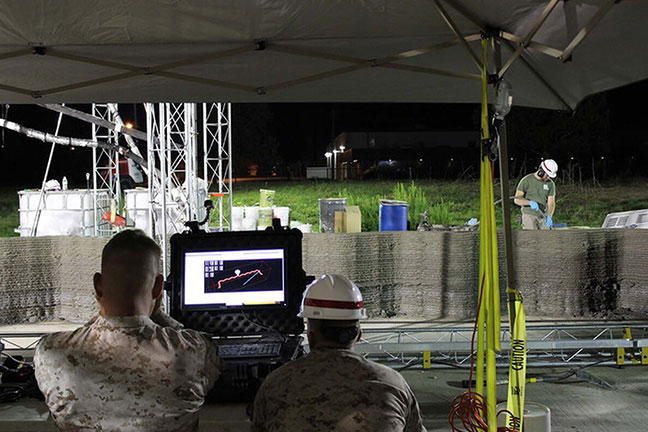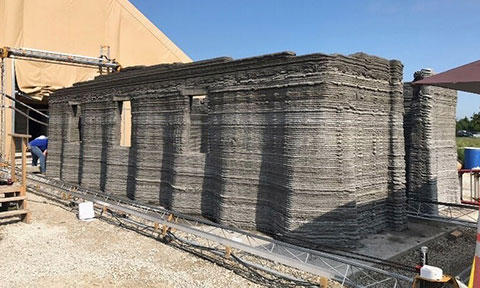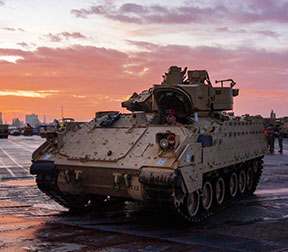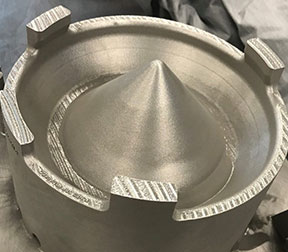3D printing tecnology is being embraced by the U.S. Military.

The U.S. Military is investing millions of dollars in 3D printing techology, also known as additive manufacturing. Prototypes, components, replacement parts, you name it, the military is researching how things can be made faster, better and cheaper. In the past few years, 3D printing has literally grown from desktop machines to printers that are large enough to print buildings.

The Future Of Military Structures.
In August 2017 the U.S. Army showed off one of the earliest barracks constructed with 3D printed technology at the Construction Engineering Research Laboratory in Champaign, IL. The “B-Hut” is nothing to look at but according to Mike McCarthy, deputy to the commanding general for the Maneuver Support Center of Excellence at For Leonard Wood, MI, this process takes 40 percent less time then traditional methods and has significant cost savings.

 August 2018 the Additive Manufacturing Team at Marine Corps Systems Command teamed up with Marines from I Marine Expeditionary Force to operate, what was then, the world's largest concrete 3D printer at the U.S. Army Engineer Research and Development Center in Champaign, Illinois. As a joint effort between the Marine Corps, Army and Navy Seabees, an expeditionary concrete 3D printer was used to print a 500-square-foot barracks hut in 40 hours. With the addition of a robot to do the mixing and pumping, which was marine powered for this job, it’s expected the building could easily be created in one day. It normally takes 10 Marines five days to construct a barracks hut out of wood. With this FUE (first unit equipped), the Marine Corps proved four Marines with a concrete printer can build a strong structure in less than two days. READ MORE HERE.
August 2018 the Additive Manufacturing Team at Marine Corps Systems Command teamed up with Marines from I Marine Expeditionary Force to operate, what was then, the world's largest concrete 3D printer at the U.S. Army Engineer Research and Development Center in Champaign, Illinois. As a joint effort between the Marine Corps, Army and Navy Seabees, an expeditionary concrete 3D printer was used to print a 500-square-foot barracks hut in 40 hours. With the addition of a robot to do the mixing and pumping, which was marine powered for this job, it’s expected the building could easily be created in one day. It normally takes 10 Marines five days to construct a barracks hut out of wood. With this FUE (first unit equipped), the Marine Corps proved four Marines with a concrete printer can build a strong structure in less than two days. READ MORE HERE.
![]() Ideally, the Marines use of concrete printers will span the full range of military operations, from combat environments to humanitarian aid and disaster relief missions. 3D printing is expanding to create functional concrete structures like footbridges, vehicle hides and barracks. ICON is working with the DIU (Defense Innovation Unit) to develop new military applications for a range of commercial additive manufacturing technologies. As part of the project, eight Marines were trained to use ICON’s 3800 pound Vulcan 3D printer, operating software and material delivery subsystems. Following their crash course of just a few hours of training, the Marines managed to build a vehicle hide structure in just 36 hours. To learn more about the project, GO HERE.
Ideally, the Marines use of concrete printers will span the full range of military operations, from combat environments to humanitarian aid and disaster relief missions. 3D printing is expanding to create functional concrete structures like footbridges, vehicle hides and barracks. ICON is working with the DIU (Defense Innovation Unit) to develop new military applications for a range of commercial additive manufacturing technologies. As part of the project, eight Marines were trained to use ICON’s 3800 pound Vulcan 3D printer, operating software and material delivery subsystems. Following their crash course of just a few hours of training, the Marines managed to build a vehicle hide structure in just 36 hours. To learn more about the project, GO HERE.
3D printed structures take less time, cost substantially less and take far less manpower because construction can be executed by robotics with the push of a button. Expect 3D printed structures to be used by every military branch in the near future.

The Future Of Military 3D Printing
Structures are not the only thing the U.S. military is researching. Part of the challenge in 3D printing new components is using the right feedstock—the material fed into the 3D printer to print the component. Researchers need to understand the combination of materials and what amounts will create the desired properties, such as strength or stiffness. Titanium, carbon fiber, recycled plastics and other materials are currently being used to print 3D vehicles, parts and equipment.
The U.S. Navy 3D prints submarine hull.
In 2017 the Navy 3D printed a carbon fiber small submarine hull. The OMTC (Optionally Manned Technology Demonstrator) was unveiled on July 24, 2017. Fabricated by the high-tech Big Area Additive Manufacturing 3D printing machine at the Oak Ridge National Laboratory, the 30-foot submersible hull was inspired by the SEAL Delivery Vehicles used by the branch and U.S. Special Operations Command to deploy Navy special warriors and their gear into particularly dangerous areas. A traditionally built SEAL submarine costs up to $800,000 and take three to five months to manufacture. The OMTD took less than a month and only $60,000 to assemble. It’s likely that the OMTD is being field tested today.
The Army researches advanced metals.
The Army is developing the world’s largest, fastest most precise metal 3D printer. The project is a collaboration between the DEVCOM (U.S. Army Combat Capabilities Development Command), 3D Systems, a leader in 3D printing technology, and the Clemson Composites Center at Clemson University. With a build volume of approximately 1 yard x 1 yard x 2 feet, large components can be printed and assembled on site in a fraction of the time and cost of traditional methods. In addition, the Army Research Laboratory is working to engineer new, lightweight yet survivable vehicle parts such as brackets, turret components, propulsion systems, and weapons, using 3D printing technology. In particular, they are exploring the use of lightweight metals such as titanium, titanium alloys, and hybrid ceramic tile/polymer-matrix composites. Rather than secure replacement parts for a warehouse thousands of miles away, the goal is to have 3D printers creating needed parts onsite making equipment fight ready faster and less costly.
Airforce focuses on propulsion.
Not to be outdone, the Air and Space Forces are printing thousands of parts for airplanes and satellites. The Air Force Rapid Sustainability Office (RSO) reached a milestone in collaboration with General Electric to 3D print metal engine parts by printing a metal sump cover for F-110 engines used by both F-15 and F-16 fighter jets. Propulsion is obviously a key element of the Air and Space Forces. 3D printing parts and creating prototypes for new components speeds the process with huge cost savings. 3D printing is making dramatic advancements in military equipment and parts ensuring that the U.S. Military remains the premier force on the planet.Military Home Services helps veteran and active-duty military members by making home purchase and sales more affordable with cash-back rebates, experienced Realtors and expert VA loan officers. ENROLL HERE.
